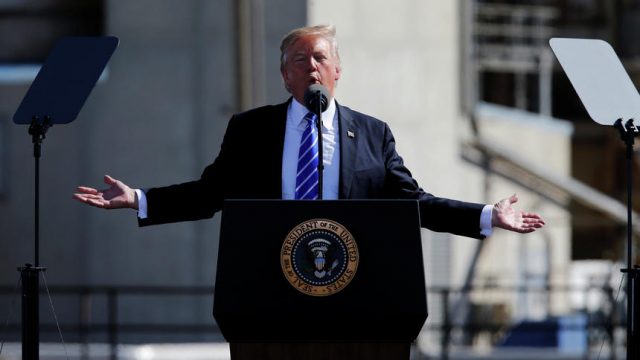Connie Krapp: You’ve Come a Long Way North Dakota

U.S. President Donald Trump delivers remarks on his proposed changes to the tax code during an event with energy workers at the Andeavor Refinery in Mandan, North Dakota, U.S. September 6, 2017. REUTERS/Jonathan Ernst
I was humbled to be part of the crowd invited to see the president at the Andeavor Refinery in Mandan. It was the second time in my life that I was part of a crowd addressed by a serving president. The first was when our son shook President Clinton’s hand as he graduated from the US Air Force Academy.
I don’t care what your politics are—when offered an opportunity to witness first-hand the President of the United States, you should love your country enough to respectfully attend. Of the two presidents I’ve witnessed, both are human and both are fallible. One is a Democrat, and one is a Republican—and neither can be held up as particularly morally motivating. Both, at one time or another, displayed behavior unbecoming of the office.
But I know that record is not just specific to Clinton or Trump. History can attest to impropriety in the Oval Office going back for centuries. In today’s world, though, we have managed to become obsessed with that impropriety. It is what gives network news its ratings; it’s what causes social media posts to go viral.
[mks_pullquote align=”right” width=”300″ size=”24″ bg_color=”#ffffff” txt_color=”#000000″]If you were born before 1980, you probably remember when North Dakota had such a low US world profile that it was omitted from the Rand-McNally 1989 World Atlas.[/mks_pullquote]
So it was refreshing to witness a version of President Trump unfiltered by the media. My impression is that, when you cut through all the semantics, politics, and extraneous clutter that surrounds him, he is a visionary leader. When you consider more than a 30-second video clip of a Trump presentation — and the commentary that the media feels obliged to add—you will see he is focused on the big picture.
While presenting his case for tax reform, he held up North Dakota as “an inspiring example of the amazing things that are possible when we unleash the genius of American innovators.” He continued, “I want all of America to be inspired by what’s happened in North Dakota and the North Dakota example. This state is a reminder of what can happen when we promote American jobs instead of obstructing American jobs…”
Wow.
North Dakota has come a long way.
If you were born before 1980, you probably remember when North Dakota had such a low US world profile that it was omitted from the Rand-McNally 1989 World Atlas. It was a year before that, in 1988, when we visited Ohio and were asked where North Dakota was.
“Is it further than South Dakota?” I was asked.
Such comments—along with questions about whether we have running water or electricity, or if the snow ever melted— were so commonplace when we traveled that we came to expect them.
Many US presidents served out their terms never setting foot in our state. “The Rise of the President’s Permanent Campaign,” published in 2012, shows the Dakotas as two of the most neglected states, visited during only five of the previous nine presidential terms. That Trump, who visited Bismarck during his campaign, returned only 16 months after his first visit is remarkable.
Or is it? Maybe North Dakota has arrived. Maybe we HAVE come a long way. Maybe we finally have a president who sees North Dakota for what it really is. “North Dakota is an inspiring example of the amazing things that are possible when we unleash the genius of American innovators,” he said.
Yes, Trump has a vision that will move this country forward. And North Dakota is in the lead. We’re not just on the map, we are the destination.
North Dakota, you’ve come a long, long way.




